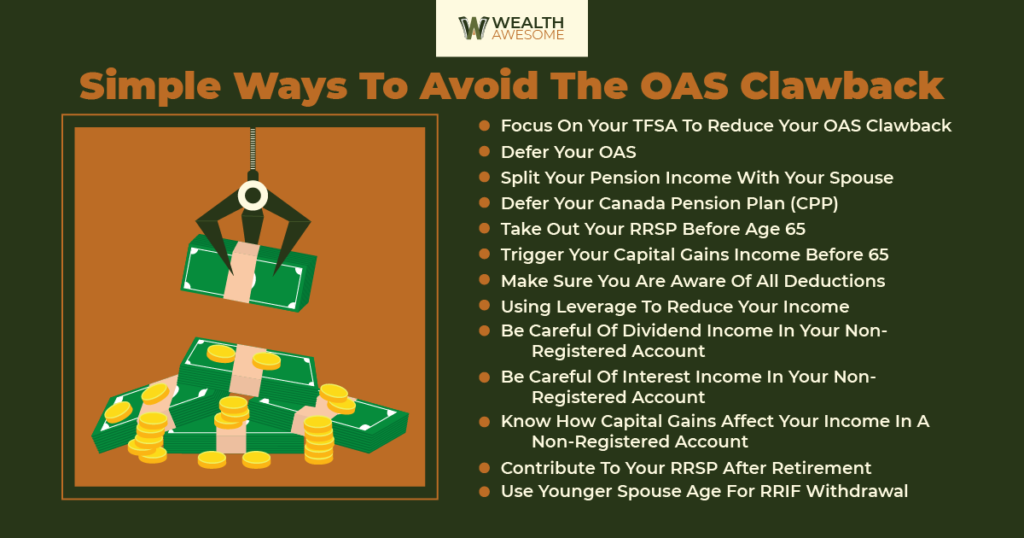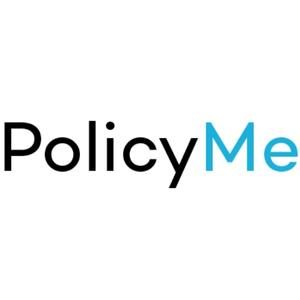With the cost of living going up in Canada, retirees need all the money they can get.
If you’re approaching retirement age, you might be worried about the Old Age Security (OAS) recovery tax, also known as the OAS clawback.
Here are some effective strategies to avoid or minimize the OAS clawback to keep more income for your golden years.
How Does the Old Age Security (OAS) Clawback Work?
If your global net income surpasses the limit set at $81,761 for 2022, you’ll need to return a portion or all of your OAS pension. This is implemented as a monthly deduction.
| Deduction Timeframe | Income Reference Year | Minimum Deduction Income Level | Maximum Deduction Income for Ages 65-74 | Maximum Deduction Income for Age 75 and Above |
|---|---|---|---|---|
| July 2023 – June 2024 | 2022 | $81,761 | $134,626 | $137,331 |
| July 2024 – June 2025 | 2023 | $86,912 | $142,428 | $147,979 |
Calculating the Amount of OAS clawback
To determine the amount you need to repay, find the difference between your income and the limit for that year. Begin by determining how much your income surpasses the limit. 15% of this excess should be repaid.
Example:
In 2022, the set limit is $81,761.
Suppose your 2022 income totaled $100,000. The amount to be repaid would be 15% of the difference between $100,000 and $81,761:
$100,000 – $81,761 = $18,239
$18,239 x 0.15 = $2,735.85
So for the period from July 2023 to June 2024, you’d be responsible for returning $2,735.85 as an OAS clawback.
Note that the pay period for OAS is from the July to June period for the previous year. For example, your 2022 income will determine if your July 2023 – June 2024 OAS will be clawed back or not.
How to Minimize or Reduce Old Age Security (OAS) Clawback

If you hate the idea of having your OAS clawed back, don’t worry! Here are some promising strategies to reduce or eliminate your OAS clawback:
1. Focus on your TFSA to reduce your OAS clawback
Any increases in your TFSA from investments will not count towards income. Make sure you are getting the most out of your TFSA. If you have any non-registered investments or savings and your TFSA is not maxed out, move it over into your TFSA.
2. Defer your OAS
You can defer your OAS when you turn 65 for up to five years. Delaying your OAS will have two positive effects:
- You’ll receive more OAS, as you’ll receive an increase in your monthly pension by 0.6% every month you delay. After five years, you will receive 36% more per month of your OAS!
- By deferring your OAS, you also have the added benefit of increasing the ceiling you can earn before not receiving any OAS. If you defer, you can earn more than the maximum and still receive some OAS. Since your OAS benefit will be higher, it will take more income to claw it back.
If your income is high from age 65 to 70, consider this strategy.
3. Split your pension income with your spouse
If your spouse or common-law partner makes significantly less than you do, consider splitting your pension income. You can split up to 50% of your registered retirement income fund (RRIF), CPP, annuity income, or pension income.
4. Defer your Canada Pension Plan (CPP)
You can defer your CPP up to age 70. There are a couple of benefits to doing so. If you delay until age 70, you could withdraw 42% more than you could have at age 65. By deferring your CPP, you would have less income from age 65 to 70.
There are other factors you will need to consider, such as your health. If your health is stable, you might want to consider delaying your payments until you are 70. By contrast, if your health is poor, it might be best not to delay taking out the payment.
Here’s a full guide to your CPP Pension – Should You Take it at Age 60, 65, or 70?
5. Take out your RRSP before age 65
By taking out your RRSP before age 65, you can declare most of your RRSP income, and this could have you fall below the OAS clawback threshold.
For example, if you’ve calculated that you’ll be making $100,000 per year, but $30,000 of that will be RRSP income if you have already withdrawn that RRSP before you’re 65, that income won’t be counted in your OAS clawback amount.
Be wary because by doing this, you will be losing out on the tax deferral benefit of your RRSP. You have to decide for yourself whether the amount you will save on the OAS clawback is worth more than the tax deferral from your RRSP.
6. Trigger your capital gains income before 65
If you have property or non-registered investments that have built up substantial capital gains over the years, you might want to sell them and trigger the capital gains income before you turn 65 to prevent triggering OAS clawbacks.
7. Make sure you are aware of all deductions
Make sure you are deducting all you can from your income, such as any business expenses if you own a business or interest on your mortgage if you have a rental property.
8. Using leverage to reduce your income
If you have borrowed money to earn investment income, you can write off the interest on the loan to lower your income. I would not recommend taking out debt to do this strategy, but if you’ve already done this, make sure you’re deducting that interest income.
9. Be careful of dividend income in your non-registered account
Usually, I’m a huge fan of dividend income. However, in the case of trying to reduce your income, earning dividend income can hurt you. Due to the dividend tax credit, your dividend income is grossed up 138%. For every dollar you’re earning in dividends, you will be declaring $1.38 of income.
A great way to get around this is to invest in swapped ETFs in your non-registered accounts. You get the benefits of low-cost ETFs and their diversification of it, but because the swapped ETFs don’t issue its dividends directly, you will defer the taxes until you decide to sell it. See a list of Horizon swapped ETFs here as an example.
10. Be careful of interest income in your non-registered account
Be mindful of investing in interest-only investments such as GICs and high-interest savings accounts in your non-registered accounts. 100% of the income will be included in your income calculation and could push you over the OAS clawback amount.
11. Know how capital gains affect your income in a non-registered account
Capital gains only count 50% of your income in your non-registered accounts. Be aware of this when doing your tax planning and OAS management.
12. Contribute to your RRSP after retirement
You can still contribute to your RRSP even after you retire, up until you turn 71. If you still have some contribution room available, it could be worth it to contribute to your RRSP to reduce your income.
This could be a fantastic strategy if your income will be higher in the first few years that you turn 65 to 70. Make sure you calculate your RRIF payments carefully to make sure you’re not running into the same clawback problems as you get past the age of 71.
13. Use younger spouse age for RRIF withdrawal
If your spouse is younger than you, you can use his or her age as your minimum RRIF withdrawal amount. This will lower the amount of RRIF income you will have to claim.
Multiple Clawbacks in Retirement Finances
In Canada, retirees need to account for more than just the OAS clawback when planning their financial futures. Numerous clawbacks might eat into their retirement income, necessitating a strategic approach.
Example:
Let’s say Margaret, a retiree, receives a monthly CPP (Canada Pension Plan) payout of $800, an OAS of $600, and earns an additional $1,000 monthly from her investment portfolio.
While her CPP income won’t trigger the OAS clawback, the combined effect of her CPP, OAS, and investment income might push her over the threshold, activating the clawback.
However, her investment income might have different implications for another benefit she receives, like the Guaranteed Income Supplement (GIS), which has its own set of thresholds.
Also, if Margaret decides to withdraw a lump sum from her RRSP, this could potentially amplify the clawback effect on her OAS and GIS benefits due to the increased reported income for that year.
This illustrates why retirees like Margaret need to adopt a comprehensive view of their income, understanding the nuances of each income source—from pensions like CPP to investments—and how they interplay with various clawbacks.
Conclusion
Your main goal is how to reduce your income after the age of 65, so you can come under that threshold for your OAS. The OAS is “free” money from the government, so it’d be great if you can receive this! Use these tips to help avoid an OAS clawback.
Related Posts:





The example you gave for “David Smith” OAS clawback calculation is showing a wrong amount used.
Sorry there was a small typo, I fixed it now!
If you are writing about Canadian CPP and OAS, why are you showing American currency instead of Canadian currency in your photos?